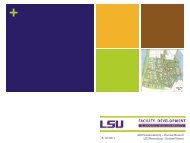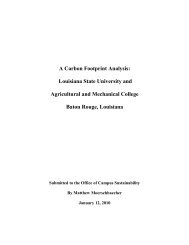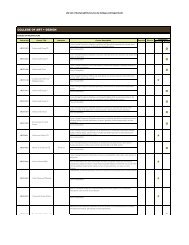Capstone Presentation - LSU Campus Sustainability
Capstone Presentation - LSU Campus Sustainability
Capstone Presentation - LSU Campus Sustainability
You also want an ePaper? Increase the reach of your titles
YUMPU automatically turns print PDFs into web optimized ePapers that Google loves.
Kyle Gravois<br />
Abby Ruiz<br />
Chad Santos<br />
Sponsor: <strong>LSU</strong> Facility Services<br />
Advisor: Dr. Nikitopoulos
Project Description<br />
Functional Decomposition<br />
Engineering Specifications<br />
Concept Generation and Selection<br />
Product Architecture<br />
Design<br />
Manufacturing and Installation<br />
Testing<br />
Budget and Schedule
<strong>LSU</strong>’s endeavor to enhance campus<br />
sustainability<br />
3 reservoir ponds for course irrigation<br />
Ponds refilled with high quality water from<br />
BRWC<br />
Water well to reduce dependence on city<br />
water<br />
Alternative renewable energy as power source<br />
Budget of $15,000
Primary Customers<br />
<strong>LSU</strong> Facility Services<br />
• Joe Kelley<br />
• Cliff Gillio<br />
• Jim Mayne<br />
<strong>Campus</strong> Committee for<br />
<strong>Sustainability</strong><br />
• Denise Scribner-Newell<br />
<strong>LSU</strong> Golf Course<br />
• Michael Johnson<br />
Secondary Customers<br />
Other golf courses<br />
• Irrigation essential for all<br />
courses<br />
Golfers<br />
• Benefit from the course’s<br />
ability to irrigate<br />
Agriculture<br />
• Remote locations with<br />
little rainfall
Produce largest volume of water possible<br />
within budget constraints<br />
Due to budget, unfeasible to completely<br />
replenish water used for irrigation<br />
• Size of well needed (at least 125 GPM for 24 hours)<br />
Water Quality<br />
• Need not be potable, may contain minerals (ie. Iron)<br />
• Minimal salt content
Produce maximum possible volume of water<br />
within $15,000 budget<br />
Compatible with power source<br />
• Function within range of power produced by<br />
alternative energy source<br />
Unobtrusive<br />
Low maintenance
Energy source should produce maximum<br />
possible volume of water within $15,000<br />
budget<br />
Nondestructive and unobtrusive<br />
Work within geographical constraints<br />
Low maintenance
Sand aquifers around 200 feet<br />
• Sand strata extending from Mississippi River<br />
• Water table significantly higher<br />
4 inch PVC pipe casing<br />
Exact well specifications unknown before<br />
construction
Submersible pump most common<br />
Considered pumps made for<br />
• 4 inch well casing<br />
• Depths ranging from surface level to 100 feet<br />
Wide variety of configurations<br />
• AC<br />
• DC<br />
Selected the Grundfos SQFlex Series<br />
Submersible 40 SQF-5 Pump
Grundfos 40 SQF-5 Pump<br />
• 5 Stage Centrifugal Submersible Pump<br />
• Function for 30-300 Volts and 0-8.4 Amps<br />
• Can run on AC or DC current<br />
• Pumps for up to 100 feet of head
Wind Turbine<br />
• Originally proposed source in project description<br />
Solar Energy<br />
• PV Panels<br />
• Stirling Engine<br />
Selected PV Panels<br />
• Insufficient wind speeds in Baton Rouge for Wind<br />
Turbine<br />
• PV allows for predictable power output compared to<br />
Solar Stirling Engine
To store surplus power not immediately used<br />
by system<br />
Battery Bank<br />
• Batteries<br />
• Charge controller<br />
Increases cost of system, but can increase<br />
total power<br />
Selected to not use a battery bank due to cost<br />
and maintenance issues
Mounting PV Panels can optimize solar<br />
irradiation<br />
1. Flat Plate Mounting: Permanently mounted<br />
2. Manual Seasonal Shift: Angle manually adjusted<br />
3. Daily Tracking: Controlled mechanical system<br />
tracks East to West<br />
4. Daily Tracking and Manual Seasonal Shift<br />
5. 2-Axis Tracking: Controlled mechanical system<br />
tracks seasonally and Daily
Hours<br />
8<br />
Average Peak Solar Hours<br />
7.5<br />
7<br />
6.5<br />
6<br />
5.5<br />
5<br />
4.5<br />
4<br />
3.5<br />
Flat Plate Mounting<br />
Manual Seasonal<br />
Shifting<br />
Daily Tracking<br />
Daily Tracking With<br />
Manual Seasonal Shift<br />
2-Axis<br />
3
Manual seasonal shift mount chosen<br />
• Startup costs for automated systems too high<br />
Consulting with Facility Services<br />
• FDDC<br />
• Vandalism<br />
Bench Pavilion and Shade Structure
Solar Irradiation<br />
Sunmodule 230 W Solar Panels<br />
Grundfos SQFlex Submersible Pump in well<br />
Groundwater pumped from well into piping system<br />
Reservoir Ponds
Electrical Line<br />
Water Well<br />
4” Drain Pipe<br />
Panel Array
Depth of approximately<br />
200 feet<br />
4” PVC Casing<br />
• 4”x20” well screen<br />
Water level unknown<br />
until well is constructed<br />
• Ground water level<br />
• Well drawdown<br />
Grundfos 40 SQF-5<br />
submersible pump is<br />
suitable for the expected<br />
water level range<br />
http://www.americanwatersurveyors.com/images/well-diagram.gif
Consists of eight 230 watt SolarWorld Sunmodule®<br />
solar panels<br />
Wired in series to produce 1840 watts of total power<br />
• 236.8 Volts<br />
• 7.76 Amps<br />
3” spaces between panels to reduce drag force
Wired in series using the leads provided with the<br />
panels<br />
Grounding lugs are connected to the aluminum<br />
frame of each panel<br />
• #6 bare copper grounding wire is routed to each panel<br />
All wiring routed to a solar combiner box<br />
containing a 15 amp fuse<br />
Power routed through the column and exits the<br />
footing 18” below ground
Positive, Negative, and<br />
Ground to Pump<br />
#6 Ground Wire to<br />
Grounding Rod<br />
15 amp Fuse<br />
Common<br />
Negative<br />
Common<br />
Ground<br />
Positive, Negative, and<br />
Ground From Array
Allows panel array to<br />
act as shade area<br />
• Manual seasonal shift<br />
• Supported by 2 columns<br />
Designed for 115 mph<br />
wind speeds<br />
• ASCE method for wind<br />
loads on billboards<br />
• 35 lb/ft 2 on the panel<br />
faces normal to wind
Panels directly mounted<br />
to purlin frame<br />
Bending stresses found<br />
• Beam sizes chosen with<br />
suitable safety factor<br />
4”-5.4 lb per ft. channel<br />
beams for purlins<br />
5”-6.7 lb per ft. channel<br />
beams for support<br />
beams
Necessary for array to<br />
pivot atop the two<br />
columns<br />
Composed of two pieces<br />
of 304 stainless steel<br />
Schedule 40 pipe<br />
• Outer hinge sleeve<br />
connected to the top of the<br />
columns using U-bolts<br />
• Inner hinge sleeve fitted<br />
with base plate and bolted<br />
to support beams of purlin<br />
frame
Cable supports are run from the columns to<br />
the support beams to hold the array angle<br />
• ¼” vinyl jacketed galvanized cable<br />
• 1400 lb rating<br />
Turnbuckles placed at each end of the cable<br />
to allow for adjustments
Two columns support the entire array and<br />
purlin frame 10.5 feet in the air<br />
Columns are encased in concrete footing 5<br />
foot below ground<br />
Bending and buckling stresses were found<br />
• 8” square tubing with 3/8” wall thickness chosen
Concrete footing<br />
surrounds the column in<br />
the ground<br />
Rebar cage designed to<br />
strengthen footing<br />
24” square hole 6.5’ into<br />
the ground<br />
• Rebar cage placed 6” from<br />
bottom of hole<br />
• Column placed in center of<br />
hole, 18” from the bottom of<br />
hole
Two 6 foot long, Number 4 Rebar Cages<br />
• 16”x16” squares placed 12” apart<br />
• Donated by CMC Capital Steel
Concrete Footing design changed due to<br />
capabilities of Facility Services<br />
• Augered two 6.5’ deep, 35” diameter holes<br />
16”x16”x6’ Rebar Cages placed in each hole<br />
18” concrete poured, set for 24 hours
Two A36 Steel Columns cut to length of 15 feet<br />
Conduit<br />
Base Plate<br />
Turnbuckle tabs welded
Inner Hinge Pipe<br />
3” SCH 40 pipe, 9” long<br />
Welded to 304 SS inner<br />
hinge plate<br />
7”x5”x0.5” inner hinge<br />
plate bolted to frame<br />
Outer Hinge Pipe<br />
3.5” SCH 40 pipe, 8” long<br />
U-bolted to A36 steel top<br />
plate welded at top of<br />
column
Backhoe used to insert columns into rebar cage in<br />
augered hole<br />
Stabilized by wooden frame<br />
Remaining concrete poured; set for 1 week
2 Top Row Purlins<br />
• Cut to 17.46 ft<br />
• Ten 23/64” bolt holes per purlin<br />
2 Bottom Row Purlins<br />
• Cut to 15.27ft<br />
• Six 23/64” bolts holes per purlin<br />
2 Support Beams<br />
• Cut to 8.12 ft<br />
• Welded to purlins
Outer panels bolted, crane lifted frame into<br />
position<br />
Connected to column beams by bolting inner hinge<br />
plate to support beams<br />
Remaining panels bolted
Four adjustable supports<br />
• Turnbuckles connected by galvanized cable via wire<br />
thimbles and wire clamps
Electricians from Facility<br />
Services<br />
Wiring from panels feeds<br />
into solar combiner box,<br />
then into conduit, down<br />
column, and then<br />
underground to well site
Well Construction<br />
• Contractor must be certified with the University<br />
• Difficult to find driller with necessary insurance<br />
Pump Delivery Delay<br />
• Issues with bidding in regards to pump specs<br />
• Fax machine issues<br />
• Substantially reduced testing time
Individual panel testing<br />
Power production<br />
Array angle testing<br />
Pump performance<br />
Total water production<br />
Free-flow
Each panel was tested to<br />
make sure there were no<br />
factory defects<br />
Each panel tested with<br />
multimeter to ensure that<br />
the panel was producing<br />
proper power output<br />
• All panels passed
Power readings taken every 30<br />
minutes from sunrise to sunset<br />
Submersible pump placed in<br />
testing rig provided the load on<br />
the system<br />
Current and voltage readings<br />
taken<br />
• Taken with Fluke 77-3 multimeter<br />
• Total power found from these<br />
readings
The flow rate of the system was also found<br />
every 30 minutes<br />
Flow rates were found from pump<br />
performance curve and power readings<br />
Pump performance curve checked<br />
• Measured flow rate measuring volume pumped and<br />
recording the pumping time
Could not have a well drilled in time<br />
Created test well by recirculating water in<br />
piping system
Voltage<br />
Amps<br />
Amps<br />
8<br />
6<br />
4<br />
2<br />
0<br />
Amps<br />
6:00:00 AM 8:00:00 AM 10:00:00 AM 12:00:00 PM 2:00:00 PM 4:00:00 PM 6:00:00 PM 8:00:00 PM<br />
300<br />
200<br />
Volts<br />
100<br />
0<br />
Volts<br />
6:00:00 AM 8:00:00 AM 10:00:00 AM 12:00:00 PM 2:00:00 PM 4:00:00 PM 6:00:00 PM 8:00:00 PM<br />
Time<br />
*These values are only applicable for this time of year
Power<br />
1600<br />
1400<br />
1200<br />
1000<br />
800<br />
600<br />
400<br />
200<br />
0<br />
6:00:00 AM 8:00:00 AM 10:00:00 AM 12:00:00 PM 2:00:00 PM 4:00:00 PM 6:00:00 PM 8:00:00 PM
Flow rate (GPM)<br />
Flow rate<br />
80<br />
70<br />
60<br />
50<br />
40<br />
7 Feet<br />
15 Feet<br />
35 Feet<br />
30<br />
20<br />
10<br />
50 Feet<br />
65 Feet<br />
80 Feet<br />
100 Feet<br />
0<br />
6:00:00 AM 8:00:00 AM 10:00:00 AM 12:00:00 PM 2:00:00 PM 4:00:00 PM 6:00:00 PM 8:00:00 PM<br />
Time
Percentage of Water Replaced<br />
Percentage of Water Replaced<br />
25<br />
20<br />
15<br />
10<br />
5<br />
Actual<br />
Estimated<br />
0<br />
7 15 35 50 65 80 100<br />
Head (feet)
Advisor: Dr. Nikitopoulos<br />
Sponsor: Facility Services<br />
• Jim Mayne<br />
• Cliff Gillio<br />
• Denise Scribner-Newell<br />
• Facility Services Workers
Endeavor to enhance campus sustainability<br />
Concept selection<br />
Well incomplete<br />
Testing results<br />
Product effectiveness<br />
Remaining budget





